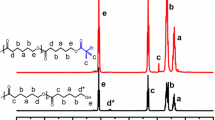Abstract
The entrapment of Adriamycin (ADR) in micelles composed of AB block copolymers (poly(ethylene oxide-co-β-benzyl L-aspartate) (PEO-PBLA)) was investigated. The loading process involved transfer of ADR and PEO-PBLA into an aqueous milieu from dimethyl-formamide (DMF) through a dialysis procedure. Evidence for the physical entrapment of ADR in the polymeric micelles was derived from fluorescence spectroscopy and gel permeation chromatography (GPC). The total fluorescence intensity of ADR was low, suggesting that the drug was self-associated in the micelles. In addition, quenching experiments, using a water-soluble quencher (iodide (I–)), showed that the fluorescence of ADR present in micellar solutions was largely unaffected by I–, whereas the fluorescence of free ADR was readily quenched. From Stern-Volmer plots, quenching constants (KSV) of 2.2 and 17 M−l were determined for ADR in micellar solutions and free ADR, respectively. As a result of the entrapment of ADR in the micelles, ADR binds only slightly serum albumin as evidenced by GPC. In contrast, ADR readily binds serum albumin in aqueous solutions. The findings suggest that ADR is stably entrapped in PEO-PBLA micelles. ADR entrapment in polymeric micelles is expected to affect markedly the pharmacokinetics of ADR.
Similar content being viewed by others
REFERENCES
M. Malmsten and B. Lindman. Self-assembly in aqueous block copolymer solutions. Macromolecules 25:5440–5445 (1992).
K. Kataoka, G. S. Kwon, M. Yokoyama, T. Okano, and Y. Sakurai. Block copolymer micelles as vehicles for drug delivery. J. Controlled Release 24:119–132 (1993).
R. Nagarajan, M. Barry, and E. Ruckenstein. Unusual selectivity in solubilization by block copolymer micelles. Langmuir 2:210–215 (1986).
C. Zhao, M. Winnik, G. Reiss, and M. Croucher. Fluorescence probe technique used to study micelle formation in watersoluble block copolymers. Langmuir 6:514–516 (1990).
G. S. Kwon, M. Naito, M. Yokoyama, T. Okano, Y. Sakurai, and K. Kataoka. Polymeric micelles based on ab block copolymers of poly(ethylene oxide) and poly(B-benzyl L-aspartate). Langmuir 9:945–949 (1993).
G. S. Kwon, M. Naito, M. Yokoyama, T. Okano, Y. Sakurai, and K. Kataoka. Block copolymer micelles as vehicles for hydrophobic drugs. Colloids and Surfaces B:Biointerfaces 2:429–434 (1994).
M. Yokoyama, G. S. Kwon, T. Okano, Y. Sakurai, T. Seto, and K. Kataoka. Preparation of micelle-forming polymer-drug conjugates. Bioconjugate Chem. 3:295–301 (1992).
R. Goldman, T. Facchinetti, D. Bach, A. Raz, and M. Shinitzky. A differential interaction of daunomycin, adriamycin and their derivatives with human erythrocytes and phospholipid bilayers. Biochim. Biophys. Acta 512:254–269 (1978).
P. Bahadur, N. V. Sastry, and Y. K. Rao. Interaction studies of styrene-ethylene oxide block copolymers with ionic surfactants in aqueous solutions. Colloids and Surfaces 29:343–358 (1988).
S. S. Lehrer. Solute perturbation of protein fluorescence. The quenching of trytophyl fluorescence of model compounds and of lysozyme by iodide ions. Biochemistry 10:3254–3263 (1971).
G. S. Karczmar and T. R. Tritton. The interaction of adriamycin with small unilamellar vesicle liposomes. Biochim. Biophys. Acta 557:306–319 (1979).
D. W. Urry, S. Peng, T. Parker, D. Gowda, and R. D. Harris. Relative significance of electrostatic-and hydrophobic-induced pKa shifts in a model protein: the aspartic acid residue. Angew. Chem. Int. Ed. Engl. 32:1440–1442 (1993).
M. Yokoyama, T. Okano, Y. Sakurai, H. Ekimoto, C. Shibazaki, and K. Kataoka. Toxicity and antitumor activity against solid tumors of micelle-forming polymeric anticancer drug and its extremely long circulation in blood. Cancer Res. 51:3229–3236 (1991).
G. S. Kwon, M. Yokoyama, T. Okano, Y. Sakurai, and K. Kataoka. Biodistribution of micelle-forming polymer-drug conjugates. Pharm. Res. 10:970–974 (1993).
A. A. Gabizon, Y. Barenholz, and M. Bialer. Prolongation of the circulation of doxorubicin encapsulated in liposomes containing a polyethylene glycol-derivatized phospholipid: pharmacokinetic studies in rodents and dogs. Pharm Res. 10:703–714 (1993).
Author information
Authors and Affiliations
Rights and permissions
About this article
Cite this article
Kwon, G.S., Naito, M., Yokoyama, M. et al. Physical Entrapment of Adriamycin in AB Block Copolymer Micelles. Pharm Res 12, 192–195 (1995). https://doi.org/10.1023/A:1016266523505
Issue Date:
DOI: https://doi.org/10.1023/A:1016266523505




